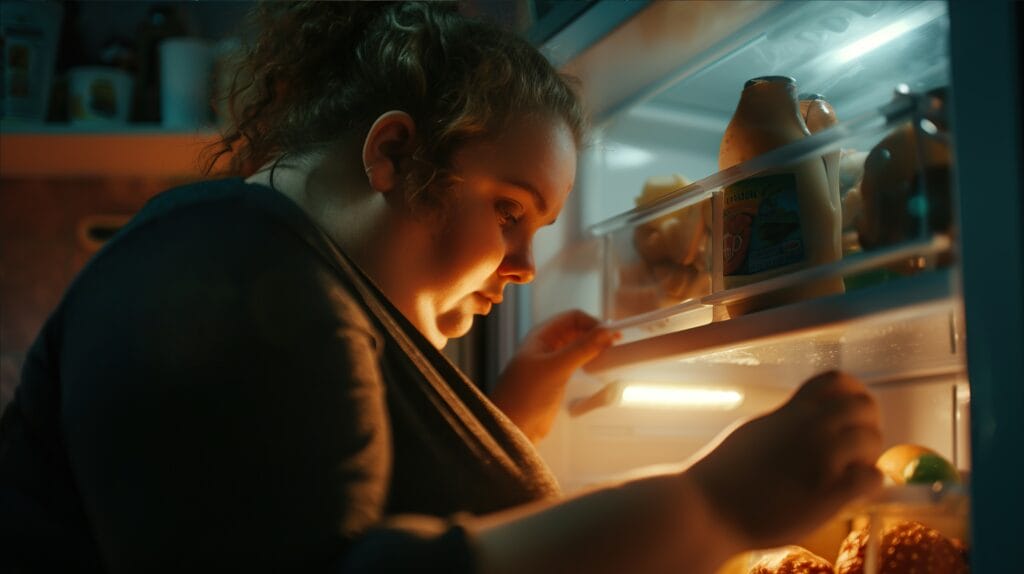At the UC San Diego Center for Healthy Eating and Activity Research (CHEAR), we employ a variety of therapeutic interventions to help individuals reduce binge eating and overeating. Among these methods, exposure therapy is a key approach that targets both the physiological sensations and cognitive experiences associated with highly craved foods. A mental health professional guides the exposure therapy process, ensuring it is conducted correctly and providing a supportive environment for patients as they confront their fears.
What is Exposure Therapy?
Exposure therapy is a well-established treatment method used to address anxiety, phobias, and eating disorders. The core principle of exposure therapy is to help individuals confront and reduce their unwanted responses to specific stimuli by gradually exposing them to these triggers in a controlled and safe environment.
For instance, if someone has a fear of spiders, a clinician might begin by showing them pictures of spiders, then move on to videos, and eventually have them observe a real spider. This gradual exposure helps the individual become desensitized to the fear-inducing stimulus, reducing their anxiety over time. Systematic desensitization, a specific method within exposure therapy, involves this gradual exposure combined with relaxation techniques, making it particularly effective at reducing anxiety and avoidance behaviors.
At CHEAR, we apply this concept to help our patients manage binge eating and overeating. Our approach involves exposing patients to highly craved foods in a way that allows them to engage with the food without consuming it fully. This process is done through mindful eating practices, where patients use their senses to experience the food (such as smelling, tasting, and holding it) but stop short of finishing it.
The goal of this method is to help patients experience their cravings and physiological arousal without giving in to the urge to eat the entire food item. By repeatedly practicing this, patients build confidence in their ability to resist these cravings and develop healthier eating habits. Over time, this helps them gain control over their eating behaviors and reduces the frequency and intensity of binge eating episodes.
What Exposure Therapy Is Not
It’s important to clarify what exposure therapy is not. Exposure therapy is not about placing a patient in a room with a large pizza and telling them “don’t eat it.” This kind of approach is ineffective and can be harmful. Unfortunately, we know some patients who have reported experiences like this. At CHEAR, we also conduct research so we understand scientifically supported methods that are both effective and prioritize the patient’s mental and emotional well-being.
Moreover, exposure therapy at CHEAR is not about blaming the patient. It is not the patient’s fault–Biological factors play a major role in eating behaviors, more than most people understand. Binge eating is a cascade of brain responses that over respond to food and have trouble stopping once the eating starts. Our approach is designed to accept these biological factors and work with them in a non-judgmental and supportive manner. We steer clear of shame and guilt, which can be counterproductive in treatment. Instead, we focus on helping patients understand and manage their cravings in a compassionate and constructive environment.
Methods of Exposure Therapy at CHEAR
We use two main methods for exposure therapy:
- In Vivo Exposures: This involves real-time interaction with the food. Patients are guided to hold, smell, taste, and then put down the food without finishing it. This practice uses the five senses to engage with food mindfully, which is crucial for the therapy’s effectiveness.
- Imaginal Exposures: Here, patients imagine eating a particular food in a familiar setting, like enjoying a burger at their favorite restaurant. This method is equally effective and allows patients to practice without the immediate risk of overeating.
How Does Exposure Therapy Work?
Before starting exposure therapy, patients with binge eating or overeating tendencies typically follow a repetitive and reinforcing cycle. This cycle often looks like this: a person sees or thinks about a highly craved food, which triggers intense cravings. To relieve these cravings, the person consumes the food, experiencing temporary relief. This pattern, repeated over time, strengthens the association between food cues and the act of binge eating, making it harder to break the habit.
Exposure therapy is also effective for treating various anxiety-related conditions, including generalized anxiety disorder.
Disrupting the Cycle with Exposure Therapy

Exposure therapy aims to disrupt this cycle by changing how patients manage their cravings and urges to eat. Instead of giving in to cravings and finishing the food, patients are taught to engage with the food mindfully and resist the urge to consume it entirely. Many times, this is the first time they have resisted consuming the whole thing. By teaching this skill, the therapy gives patients more control over their eating, thereby improving the individual’s quality of life. Here’s how this process unfolds:
- Initial Interaction: During therapy sessions, patients are exposed to highly craved foods. They may hold, smell, and even taste the food, but they do not eat it entirely. This initial interaction with the food often increases physiological arousal and cravings.
- Mindful Eating: Patients practice mindful eating, which involves using all five senses to experience the food. They pay close attention to the look, smell, taste, texture, and even sound of the food. This heightened awareness helps them fully experience the craving without acting on it.
- Gradual Exposure: Over time, through repeated exposure sessions, patients become more accustomed to the presence of the food without feeling compelled to consume it. This gradual and controlled exposure reduces the intensity of cravings and helps patients manage their responses more effectively.
Inhibitory Learning
This process is known as “inhibitory learning.” It involves creating new, healthier responses to food cues that inhibit the old, maladaptive eating behaviors. As patients continue to practice this new way of engaging with food, they build new habits that counteract their previous tendencies to binge eat.
- Breaking Old Patterns: Inhibitory learning helps patients break the automatic pattern of responding to food cues by binge eating. Instead, they learn to resist the urge and manage their cravings.
- Building New Habits: Through consistent practice, patients develop new habits that prioritize mindful eating and self-control. These new habits gradually replace the old, harmful patterns.
Long-Term Benefits
Over time, patients who undergo exposure therapy report a significant reduction in binge eating episodes. They gain confidence in their ability to resist cravings and develop a healthier relationship with food. They gain space to make a choice, rather than acting only on habit. By disrupting the old cycle and reinforcing new, positive behaviors, exposure therapy provides a powerful tool for long-term recovery from binge eating and overeating.
Overall, exposure therapy helps patients regain control over their eating behaviors, leading to improved self-efficacy and a better quality of life.
Post-Exposure Processing
Post-exposure processing is a crucial component of exposure therapy that occurs after each exposure session. This reflective practice helps patients consolidate their new experiences into memory and reinforce healthier interactions with food. Here’s how it works:
Reflecting on Cravings and Responses
After an exposure session, patients are encouraged to reflect on their cravings, expectations, and physiological responses. This involves asking themselves questions like:
- What did I expect to happen when I was exposed to the food?
- How strong were my cravings, and how did they change throughout the exposure?
- What physical sensations did I experience (e.g., increased heart rate, salivation)?
- How did I feel emotionally during the exposure (e.g., anxious, calm, empowered)?
By systematically examining these aspects, patients gain a deeper understanding of their reactions to highly craved foods and how their responses evolve during the exposure.

Identifying Patterns and Insights
During post-exposure processing, patients often identify patterns in their cravings and responses. For example, they might notice that their cravings peak at the beginning of the exposure but gradually decrease as they practice mindful eating. They might also realize that certain expectations (e.g., “I won’t be able to resist eating the whole thing”) are not as accurate as they initially believed.
Patients may also uncover important insights, such as:
- Recognizing specific triggers that heighten cravings (e.g., the smell of food, certain visual cues).
- Noticing how their thoughts and feelings influence their eating behaviors.
- Understanding that cravings can be managed and do not necessarily lead to binge eating.
Solidifying New Experiences
Post-exposure processing helps solidify the new experiences gained during the exposure. By reflecting on their ability to resist cravings and manage physiological arousal, patients reinforce their confidence in handling highly craved foods. This reflection is essential for embedding the new, healthier responses into their behavior patterns.
Building Confidence and Self-Efficacy
Over time, consistent post-exposure processing leads to increased self-efficacy—the belief in one’s ability to succeed in specific situations. As patients repeatedly engage in exposures and reflect on their experiences, they gain “distance” from the experience and build confidence in their ability to resist highly craved foods. This growing confidence is vital for long-term success in managing binge eating and overeating.
Creating a Positive Feedback Loop
The process of post-exposure reflection creates a positive feedback loop:
- Exposure Session: Patients engage with highly craved foods mindfully, practicing resistance.
- Reflection: Patients reflect on their cravings, expectations, and physiological responses, gaining insights and identifying patterns.
- Consolidation: These reflections help solidify the new experiences in memory and reinforce healthier interactions with food.
- Increased Confidence: As patients recognize their ability to manage cravings, their confidence and self-efficacy grow.
- Improved Behavior: Increased confidence leads to more successful exposures and further reinforces the new, healthier eating behaviors.
Through this positive feedback loop, post-exposure processing plays a vital role in helping patients develop lasting control over their eating behaviors, ultimately supporting their recovery from binge eating and overeating.
Patient Experiences with Exposure Therapy
Empowerment Through Control
One of the most significant benefits patients experience with exposure therapy is a sense of empowerment. Many patients enter therapy feeling that their cravings and eating habits control them. However, through exposure therapy, they learn that they have the power to make conscious choices about their eating behaviors. This newfound control is profoundly empowering and can be a pivotal moment in their recovery journey.

Choice and Flexibility
Patients report that exposure therapy helps them realize they have choices when it comes to food. They learn that they are not compelled to eat an entire portion and that it’s okay to have just a small amount or none at all. This realization can be liberating, as it shifts their mindset from feeling powerless to having flexibility and control over their eating decisions.
First-Time Experiences
For many patients, exposure therapy introduces them to new behaviors around food. For instance, it might be the first time they’ve ever intentionally thrown away food instead of finishing it. This act, though simple, can be highly symbolic and transformative. It signifies that they are no longer dictated by the compulsion to eat everything in front of them and can make choices aligned with their health goals.
Initial Challenges and Overcoming Them
Initially, exposure therapy can be quite challenging for patients. The process of facing highly craved foods without succumbing to the urge to eat them entirely can evoke strong emotional responses, such as anxiety, sadness, or frustration. Some patients might cry or feel a deep sense of discomfort. However, these challenges are a normal part of the therapeutic process.
Support and Processing
To help patients navigate these challenges, clinicians at CHEAR provide robust support and guidance. Each exposure session is followed by thorough post-exposure processing, where patients discuss their feelings and experiences. This processing helps patients understand their reactions and build strategies to cope with similar situations in the future.
Long-Term Benefits and Satisfaction
Despite the initial difficulties, most patients find exposure therapy to be highly beneficial in the long run. They report feeling a great sense of satisfaction and accomplishment as they progress through the therapy. Successfully resisting cravings and managing their responses to food reinforces their confidence and self-efficacy.
Patients often describe the therapy as a turning point in their recovery, helping them reclaim control over their eating behaviors and develop healthier relationships with food. The experience of making conscious choices about food, resisting cravings, and practicing mindful eating contributes to their overall sense of well-being and recovery.
Personal Growth and Self-Discovery
Through exposure therapy, patients also experience personal growth and self-discovery. They learn more about their triggers, cravings, and emotional responses to food. This self-awareness is crucial for developing long-term strategies to maintain healthy eating behaviors.
In summary, patients’ experiences with exposure therapy at CHEAR highlight the therapy’s transformative potential. It empowers them to take control of their eating habits, introduces them to new and healthier behaviors, and provides the support needed to overcome initial challenges. Over time, these experiences contribute to significant improvements in their recovery from binge eating and overeating, leading to lasting positive changes in their lives.
Empowering Patients with Exposure Therapy for Lasting Change
Exposure therapy is a powerful tool for treating binge eating and overeating. At CHEAR, we ensure that these processes are conducted with a deep understanding of their purpose and the underlying research. Our goal is to help patients gain control over their eating behaviors, providing them with the skills and confidence needed for lasting change.




